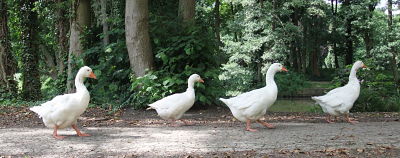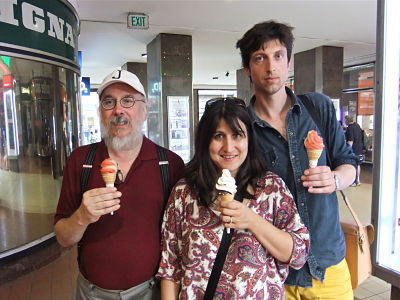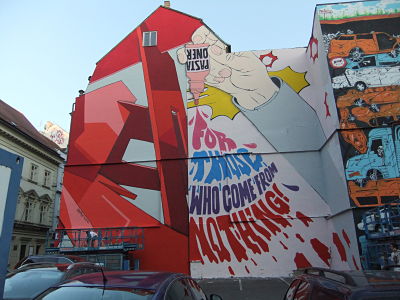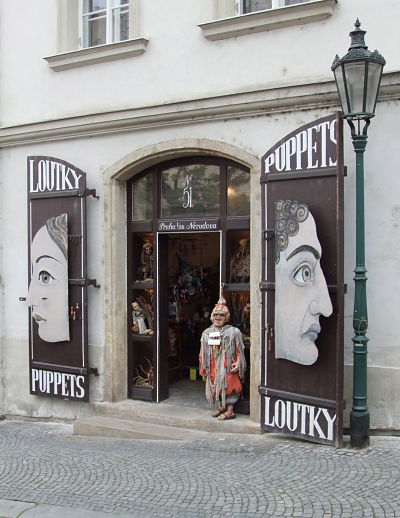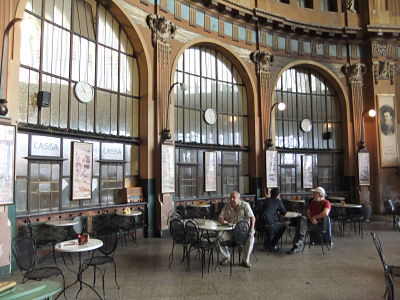How I Spent My Summer Vacation: Germany (Round Two) and the Czech Republic
/Delmonhorst and Breman, Germany
Our travels next took us back through Germany -- to the town of Delmonhorst in Lower Saxony. Here, I participated in a conference, organized by Martin Butler and centering around the "precarious alliances" which shape the relations between authors, readers, editors, publishers, translators, critics, archivists, and booksellers, among others, each of whom helps to shape the nature of literary production. This was an intimate event -- roughly 20 academics, mostly European, a few American -- sat around in a seminar room for three days and talked about each other's work. For me, this kind of prolonged engagement was a rare treat, especially when coupled with the fact that the topic -- which centered mostly around print culture -- was a little askew to what I normally look at and most of the papers, by and large, focused on pre-20th century forms of publication. I gave the opening keynote, using J.K. Rowling's complex relations with Harry Potter fans and readers, as the central focus of my analysis, but giving the group a taste of what publication means in the era of "spreadable media."
The other keynote talks came from James L. West Jr. (Penn State), who has helped to manage the republication of the works of F. Scott Fitzergerald, and shared some of the behind the scenes negotiations which shape posthumous publications (and along the way, told some great stories about consulting with Baz Luhrman on the forthcoming, now delayed, Great Gatsby movie), Wil Verhoeven (Gronigen) who spoke about "print capitalism" and the establishment of "political modernity" in England, and Claire Squires (Stirling), author of Marketing Literature: The Making of Contemporary Writing in Britain, who described the ways new modes of digital publishing and online book selling were disrupting older printing practices. Other memorable presentations include a critique of the rhetoric of participation as deployed by some contemporary marketing projects by Martin Butler (Olderberg), a talk on the packaging of best selling genre fiction in Post-socialist Russia by Ulrich Schmid (St. Gallen), a discussion of the political and cultural debates surrounding the Booker Prize by Anna Augustcik (Oldenburg), and a talk about the construct of the impoverished author in early Modern France by Geoffrey Turnovsky (Seattle). These exchanges, which dealt with print as a medium and as a set of cultural practices, rather than as a fixed canon of great works, were refreshing for me and seemed to open a path forward for future multidisciplinary conversations around similar topics.
Cynthia and I especially enjoyed getting to know Verhoeven and his partner, Amanda Gilroy, who drove down precisely to meet me. Gilroy recently published a fascinating essay dealing with how she used fan fiction writing activities to get her students to engage more closely with the works of Jane Austin, an essay I know would be of particular interest to many of our readers.
The conference organizers allowed a fair amount of downtown for us to explore the city and its surrounding area. A few blocks from our hotel, there was a beautiful park, where we ran into this brace of ducks.
And in the town proper, we had yet another Spider-man sighting. It would seem that for a U.S.-based superhero, he gets around!
One night, a party of the speakers went into Breman, nearby, for dinner and a stroll around the historic districts of this German city, which was referenced by Ptolemy as early as 150 AD. Like many German cities, Breman was heavily bombed during the Second World War, but it has made concerted efforts to restore some of the beautiful old buildings.
Praha (Prague), Czech Republic
When I arrived in Praha, I was greeted with posters depicting me as a somewhat paunchy superhero, flying high above the Žižkov Television Tower, a local landmark. These posters had been made by Luis Blackaller, a former MIT Media Lab student, who now lives in Los Angeles and occasionally sits in on my classes.
The poster had been commissioned by Jaroslav Švelch, who had spent several years as a visiting scholar through the MIT Comparative Media Studies Program, and now teaches on the Charles University Faculty of Social Sciences. Svelch had helped to organize a day-long symposium, Transmedia Generation: On Empowered and Impassioned Audiences in the Age of Media Convergences, in honor of my visit. We were grateful to receive funding from the U.S. Embassy in Pradha to help support this exchange between American and Czech based scholars.
Here is my talk (a variant on the one I had given at the Telefonica conference in Madrid).
http://www.youtube.com/watch?v=FTdZN4UUXY4&feature=youtu.be
Sangita Shresthova, a former CMS Masters Student, who now heads up our Civic Paths research team at USC, flew in for the event. Shresthova is part Nepalese, part Czech, and grew up in Praha, as she notes in the opening segment of her talk about Bollywood dance and its fan following around the world. I featured Shresthova's book, Is It All in the Hips?: Around the World With Bollywood Dance, earlier this year, on my blog.
http://www.youtube.com/watch?v=VDlBDDfdjAU
Here's Švelch''s own talk which shared some of his research about fan subbing practices, especially concerning Game of Thrones, in the Czech Republic. Švelch' has a background in translation studies, even though much of his recent work has dealt with computer games and other aspects of digital culture, so this project allowed him to combine several of his interests.
http://www.youtube.com/watch?v=AabX2ZA-5MQ&feature=relmfu
I was especially intrigued by this presentation by Nico Carpentier (Free University of Brussells), who has been exploring what we can learn about new forms of participatory culture by digging more deeply into the literature around participatory democracy. I was a bit nervous when I saw the title of his talk, "The Dark Side of Online Participation," but I left enormously excited by the work he is doing. Carpentier argues that legitimate claims for advances in opportunities for meaningful participation are drowned out by a rhetoric of participation which as often as not is little more than marketing. He wants to create some conceptual models which allow us to appraise what kinds of participation are on offer, seeing meaningful participation as involving the redistribution of power and the flattening of traditional hierarchies and inequalities. This is precisely the kind of work which should be done right now at the intersection between critical and cultural studies.
http://www.youtube.com/watch?v=spOs-kwNw3U
I made no secret of my excitement over discovering Carpentier and his work when Sangita, Nico, and I shared a panel together for the symposium's final session, which dealt with the political and educational implications of the research we had presented.
http://www.youtube.com/watch?v=4IJx7OycB84&feature=relmfu
Since I have been back in Los Angeles, Carpentier and I have been working on a dialogic piece which explores more fully the similarities and differences in the ways we are thinking in our current projects about the nature of political participation.
To be honest, the conference was, in some ways, an excuse to have Švelch and Shresthova show Cynthia and I around Praha. After speaking to so many different groups and meeting so many new people, it was a luxury to be able to hang out and have fun with two old friends.
I would say that we painted the town "red," but somehow that might have a different connotation when talking about a post-socialist country. But, we had a wonderful time wandering the streets and taking tram trips together as they tried to introduce us to as much Czech culture as I could possibly absorb in a few days time.
As I sit here some weeks later and try to put into words my scattered impressions of Praha, I feel like it comes out as something like "Pretty, Shiny, Golly Whiz!", where-as something of the beauty and splendor comes through in Cynthia's photographs.
As Jaroslav, Cynthia, and I were walking along the banks of the Vltava River, we ran straight into two other Comparative Media Studies affiliates -- Zuzana Husárová and Amaranth Borsuk -- both visiting Eastern Europe to attend a conference about digital poetry and storytelling. Here, you see the Praha Castle towering over the river, while on this sunny afternoon, you can see all kinds of boats out cruising along the river.
This is Jaroslav's photograph of Cynthia and I in front of some of the old buildings which survive from the 1891 Jubilee Exhibition. We were here visiting another late 19th century panorama, in this case depicting the Battle of Lipany (fought in 1434). Our exploration of late 19th popular amusements also took us to visit a Hall of Mirrors, also from 1891, and also very much still alive as an attraction for contemporary tourists.
We were fascinated by the old world charm of Praha, especially the decorated facades of buildings which date back to the Art Nouveau period.
One of our discoveries on this trip was the work of the Czech Art Nouveau graphic artist, Alphonse Mucha, whose paintings, illustrations, advertisements, postcards, and designs captured the spirit of Prague as it entered into the 20th century. I found this video on YouTube which shares some of Mucha's story and work.
http://www.youtube.com/watch?v=OWvrIvs7LKY
But we were also very much taken by the aesthetic of contemporary Praha street art.
We were very much amused to stumble upon this fine establishment, dedicated to preserving the memory of this classic 1970s vintage American cult series and the lifestyle which it embodies. Starksy and Hutch was very much an active fandom when I wrote Textual Poachers, though I don't run across many references to it today. I wanted to share this image in honor of all of you old school fans out there!
Visiting this former Soviet block country brought back a rush of memories for me as a child of Cold War America. Perhaps the most powerful concerned the CBS Children's Film Festival, a staple of my childhood. (You can learn more about the program on this Kukla.TV fan website. )This program ran every Saturday afternoon, just as the morning cartoon shows started to give up the ghost, and spill over into programming intended for adults. The program was hosted by Kukla, Fran, and Ollie and dedicated to sharing films focusing on the lives of children from around the world. When I looked the program up on the web, I was struck by how many of the stories I remembered most vividly had come from Czechoslovakia, which was known during this period for its production of children's films. Here, for example, are segments from two of the films shown during the Children's Film Festival:
Adventure in Golden Bay Dobrodružství na Zlaté zátoce (1956)
http://www.youtube.com/watch?v=xih0OcQgjc8
Captain Korda Kapitán Korda (1970)
http://www.youtube.com/watch?v=82yaOhzjbtk
Many of the other films shown on the series came from the Soviet Union, Yugoslavia, Poland, Eastern Germany, and a range of other Warsaw Pact countries. These memories have left me very curious how it was possible for so many of these films to air on network television during a period of time when political tensions between the United States and Eastern Europe were at such a level of intensity, and also to ponder what impact this early exposure to global diversity might have had on my generation's relationship to the rest of the world. Certainly, there are children's film festivals hosted by museums and cultural institutions around the United States today, but there is no such commitment from commercial broadcasters to insure a more cosmopolitan diet for contemporary youth.
A window display of wooden marionettes suggested the continued process of cross-cultural exchange, as Charlie Chaplin, Harry Potter, and Jack Sparrow hang alongside Old World witches and trolls.
The Czech people have long been among the most accomplished puppet makers and performers in the world, and this fascination with puppetry has often influenced their filmmaking, resulting in a strong tradition of puppet animation. Looking for more information about the puppet shops and theaters we saw in Praha, I stumbled onto this website, which also shared a delightful cartoon produced by students in their summer program.
http://www.youtube.com/watch?v=tIQsmLTv6UY&feature=player_embedded
While I was in Praha, I was interviewed by Pavel Kořínek, who wanted to get my thoughts about the current state of Comics Studies, as an emerging field of research. He was nice enough to give me Český Komiks 2000-2010, a wonderful collection of contemporary Czech comics. Here's a useful Wikipedia entry that overviews the history of Czech comics. Jaroslav helped to fuel my growing interest in this graphic tradition by taking me to a small museum dedicated to the works of Kaja Saudek, perhaps the most important Czek underground comics artist of the 1960s and 1970s. Saudek was inspired both by the traditions of mainstream American comics, especially superheros but also Walt Disney and Carl Barks. He was also transformed by his encounters with the work of R. Crumb and Richard Corben. Here's what came out when these worlds collided. Saudek's work conveyed something of the spirit of the youth culture which contributed to the Prague Spring movement in 1968.

 Jaroslav and Sangita also took me to Terryho ponožky (Terry’s Socks), located by the box office at the Světozor art house cinema just off Wenceslas Square. Terry's Socks was named after Terry Gilliam who famously left a sweaty pair of socks on a Prada movie theater's stage after a public appearance. Terry's Socks is by reputation the best place to shop in Prague for DVDS. I went there in search of what I could find of the Czech New Wave film movement, and brought back some real treasures. As it happens, Americans who want to know more about the explosion of cinematic creativity which hit Praha in the 1960s can now buy a number of classic works in Criterion's Pearls of the Czech New Wave box set, released earlier this summer. See below an especially memorable sequence from Věra Chytilová's 1966 film Daisies, which is included in the anthology.
Jaroslav and Sangita also took me to Terryho ponožky (Terry’s Socks), located by the box office at the Světozor art house cinema just off Wenceslas Square. Terry's Socks was named after Terry Gilliam who famously left a sweaty pair of socks on a Prada movie theater's stage after a public appearance. Terry's Socks is by reputation the best place to shop in Prague for DVDS. I went there in search of what I could find of the Czech New Wave film movement, and brought back some real treasures. As it happens, Americans who want to know more about the explosion of cinematic creativity which hit Praha in the 1960s can now buy a number of classic works in Criterion's Pearls of the Czech New Wave box set, released earlier this summer. See below an especially memorable sequence from Věra Chytilová's 1966 film Daisies, which is included in the anthology.
http://www.youtube.com/watch?v=zm9Gh8Fpy0c
While I was in Praha, I was contacted about appearing on one of the Czech Republic's late night news program. They featured me for a full half hour, sharing my thoughts about new media literacies, digital activism, and participatory culture. What surprised me was that the interview ran in real time with the reporter Peter Fischer interviewing me in Czech, which was translated off camera into English, which I could hear on my ear phone, and then I spoke in English, which was then translated into Czech for the television viewers.
Here, you see Jaroslav and I sharing a last cool drink together in the Prague train station before Cynthia and I departed on an 8 hour rail journey to Budapest.
Coming Soon: Budapest and Bologna


